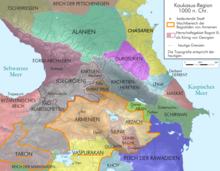Tao-Klardschetien
Tao-Klardscheti ( Georgian ტაო-კლარჯეთი, also Tao-Klardscheti ) was a medieval Georgian kingdom . It was the namesake of the former Georgian Tao province. Today the area is in Turkey , in the regions of Erzurum , Artvin , Ardahan and Kars and partly in Rize .
history
Antiquity
In ancient times, the Diaochi empire existed in Tao-Klardschetien from the 13th century BC. Later the northern parts belonged to Colchis , the south to the Persian Empire , Pontus , Armenia and the Roman Empire . Several times the south was briefly part of a Georgian state, mostly Iberia .
Creation of the kingdom
The foundation stone for the emergence of the kingdom was laid by the Erismtawari of Kartlien , the Bagratide Aschot , when he opposed the Arabs in 807 and had to flee to the southwest of his country. There he built a new state with the help of the Byzantines, which soon referred to itself as the Kingdom of the Georgians . The Byzantines also gave it the title of Kuropalat . The residence was initially the city of Artanuji . His empire included the former Iberian provinces Tao, Klardsheti, Atschara , Nigali , Schaschweti , Artaani , Speri , Samtskhe and Javakheti . Soon Aschot also succeeded in conquering a part of Inner Kartliens up to the Ksani . Ashot founded the Georgian Bagratid dynasty.
After the death of Aschot, the Arabs were able to recapture Kartlien completely, but the tribe of the Bagratids remained untouched.
Peak of power
The ruling house soon split into a Klardjet and two Taoic parts. One branch of Tao bore the title of King of Georgia, the other that of King of Tao. Nevertheless, the unity of Tao-Klardschetien remained largely intact and the economy and culture flourished. After Bagrat had helped the Arabs against the emirate of Tbilisi in order not to let it become more powerful, he was awarded Innerkartli. With this fluctuating policy between Byzantium and the Arab caliphate, the empire was able to expand its borders. In 842, Aschot's son Bagrat, in alliance with Muhammad, general of the caliph, was able to recapture Inner Cartilia from the emirate. In the 860s the area was lost to Egrisi-Abkhazia.
At the end of the 9th century the Armenian Empire of Shirak came to great power under the Armenian Bagratids. The relationship with Tao-Klardschetien was good, Adarnase II of Tao even saved Sumbat of Armenia the throne. With the rapprochement between Armenia and Egrisi-Abkhazia, however, the two states became estranged again.
In the 10th century Dawit III. von Tao significantly expand his power and thus advance the unification of Georgia. At that time Tao, along with other Christian states and Byzantium, took action against the Arabs, whose empire collapsed. For a short time, Inner Kartlien could also be recaptured, but it was lost to Abkhazia again in 924. But when from 976 to 979 Asia Minor under Bardas Scleros dared to revolt against the rule of Byzantium, all of this was in danger. Scleros conquered Armenia and almost all Asian provinces from Byzantium. When he captured the last province of Asia Minor, Nikea , in 978 , Byzantium was cut off from many sea and trade routes. Constantinople turned to Dawit II of Tao for help and he and his horsemen destroyed the troops of Scleros. In return Dawit received the areas of the Byzantine Empire up to the sources of the Arax and the upper reaches of the eastern Euphrates for the time of his life. But Dawit incorporated them into his kingdom.
After another uprising in Asia Minor in 987, this was conquered by the general Bardas Phokas , who had put down the uprising. He reached for the imperial throne and received support from Dawit. But when Phocas was defeated, Dawit had to promise to cede the areas he was given in 979 to Byzantium after his death. From 990 Dawit pushed south again and again against the Islamic states and finally reached Lake Van .
When the fight for Kartlien intensified at the end of the 10th century, Dawit was asked by the Eristawi of Inner Kartlien to protect his country. Thereupon this occupied Inner Kartlien and installed his adopted son as ruler. Since he had also become King Egrisi-Abkhazia in 978, when he took office in North Tao in 1001, the two great Georgian kingdoms united to form a united Georgian kingdom .
After Dawit's death, South Tao fell back to Byzantium.
Tao-Klardschetien remained part of the kingdom even during the Mongol period after the unification of Georgia.
Modern times
In 1551 the area of Tao-Klardschetiens was taken by the Ottomans .
After the 10th Russian Turkish War from 1877 to 1878, large parts of the region fell to the Russian Empire and formed the Kars Oblast . On April 22, 1918, the area fell to the Transcaucasian Federation , on May 26, 1918 to the Democratic Republic of Georgia . In a supplementary agreement to the Brest-Litovsk peace treaty , Soviet Russia renounced the area on August 27, 1918 on behalf of Georgia.
In the Treaty of Kars of October 23, 1921, most of Tao-Klardschetien became Turkish again. The smaller part initially belonged to the Transcaucasian SFSR , from 1936 to the Georgian SSR , from 1991 to Georgia.
religion
In Tao-Klardscheti, the monk Gregory of Chandsta from the Opiza monastery was particularly active . He and his students founded numerous Orthodox monasteries such as Chandsta , Oschki , Chachuli , Yeni Rabat İşhan , Bana and Berta. Tbeti was the most important monastery church in the Shawscheti region (around Şavşat ).
See also
literature
- Heinz Fähnrich : History of Georgia from the beginnings to Mongol rule . Shaker, Aachen 1993, ISBN 3-86111-683-9 .
- Bruno Baumgartner: Studies on the historical geography of Ṭao-Klaržeti . 2 vol., Diss. Phil. Vienna 1996 (unpublished).

